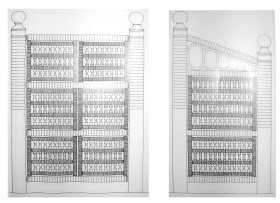Kloster Isenhagen in Hankesbuttel, Germany is one of the six cloisters situated around the Luneburger moor. Kloster Isenhagen, as well as the nearby cloister of Wienhausen was founded by Agnes of Landsberg, Duchess of Saxony. While Wienhausen was a convent for nuns, Isenhagen started as a monastery in Alt-Isenhagen in 1243. However, after a fire in 1255 the monks were transferred to another monastery and it became a Cistercienser nunnery as well. This nunnery was then moved in 1327 to its current place. While Wienhausen is a very rich and colourful convent, Isenhagen is grey and sober. It could not afford at the time to pay the masons (due to the pest) to finish the vaults of the cloister, which since remained a wooden ceiling. Notwithstanding the 'poor' looks, it contained many medieval riches for us. One of them is the chair of the founder, Duchess Agnes.
The choir of Kloster Isenhagen, visited by the St. Thomasguild in May 2012.
(Left) The cloister with the wooden ceiling instead of a brick cross vault.The starting points for the cross vault can still be seen in the wall. Also in the wall several mural cupboards (cabon) still in use to store for instance marmalade. (Right) The dark and sober hallway of the dormitory on the first floor lined with medieval chests.
The chair of Duchess Agnes stands in the choir of the convent and is a very large turned chair made of oak and ash during the first quarter of the 13th century. In the late middle ages the chair was converted into a lectern, and around 1610 some of the missing turned grids and rungs were replaced with renaissance panels. Despite the alterations, the form of the original chair can easily be seen. Of course it helps to have a drawing of the chair displayed as well... The chair is brightly painted in brick red, dark green and greyish green. The panels have a flower pattern decoration.
The early 13th century chair of Duchess Agnes converted into a lectern.
(Left) The side of the chair, here the turned rungs of the grid are painted in different colours. (Right) The front of the chair/lectern. A small door with a lock plate provides space for books (on the seating plank). On top of the lectern a small bar is nailed in the middle to prevent the sliding of the book.
A detail of the side with the small turned rungs in the grid.
(Left and Right) Details of the construction of the chair. The blue arrows show the pins that secure the side rails. The green arrows show that the tenons of the large rails transfix the legs completely. On the left photo you can see that the inserted tenon is secured by a wedge.
The chair is large: its height is 145 cm, it is 102 cm wide and 78 cm deep. The style is similar to the turned chairs of the same age found in northern countries (e.g. the bishops chair in Gamla Uppsala, Sweden). Also its former role is as a seat of authority for the Duchess is similar, and the size of the chair shows the importance of the person sitting on it.
Drawing of the original plan of the chair: back (left) and side (right). Note that the in this drawing the back of the chair shows two grids with rungs which have been replaced by panels. The side has one grid of rungs as well as the arches for the armrest replaced by panels.
Bram (with daughter) standing next to the chair showing the sheer size of it.
Another drawing of the original chair taken from the 'blue book' of Kloster Isenhagen
(Horst Appuhn, 1989. ISBN 3784504809). Here panels are shown instead of arches under the armrests.
(Horst Appuhn, 1989. ISBN 3784504809). Here panels are shown instead of arches under the armrests.
Kloster Isenhagen contains much more medieval furniture, most of the 14th century which we will show in future posts. The convent welcomes visitors (see website of Kloster Isenhagen), but is still in use and houses protestant nuns or 'Konventualinnen'.













During my woodworking evening yesterday a smart remark on the size of the chair was made: it could be the Duchess' "loveseat".
ReplyDeleteHas there been any study on what kind of paint was used? And any differences between what might have been original paint, the later modification, and the 17th century repairs?
ReplyDeleteI suppose I'm more concerned with the binder than the pigments.
There is a study by Horst Appuhn on seating furniture mentioned in the booklet of Cloister Isenhagen:
DeleteHorst Appuhn, 1978-1979. Beitrage zur geschichte der Herrschersitzes im Mittelalter, I. Teil. gedrechselte Sitze. Aachener Kunstblatter 48, page 25-52. (I do not have this, so I cannot tell what kind of information is in this paper)
Otherwise, the paint and method could be the same as used in the shrine in Kloster Wienhausen, which has been described by Babette Hartwieg. See the book page of my blog.
For some unclear reason this blogpost of mine seems to attract a lot of spam comments (which are then deleted by me) on non-woodworking subjects. To you spammers: it is a waste of time.
ReplyDeleteThis comment has been removed by a blog administrator.
ReplyDelete